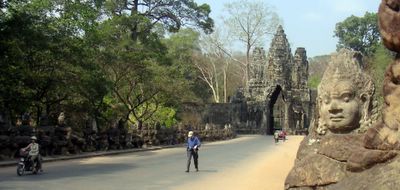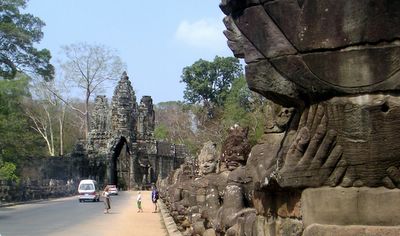Gate Make Impressive Statement

Copyright Tan and Trev 2005
Cutting an impressive figure in the mid-day sun was the distinctive south gate of Angkor Thom.
Our guide tells us that the other gates (at each point of the compass - plus one extra) were similar to the this one; however the south gate has been best restored.
The three face tower seen here is about 20 meters tall.

Copyright Tan and Trev 2005
To get inside the ancient city of Angkor Thom, vistor must drive through structure which is large enough to allow elephants and today's tourists buses to pass.

Copyright Tan and Trev 2005
Angkor Thom (built late 12th century) is the largest of the Khmer cities, about 9 square km. The entire city is surrounded by a wall 8 meters tall.
There are four gates at the center of each three kilometer long wall. A fifth gate, known as the victory gate, is on the east wall.
There is a 100 meter wide moat that encloses this wall. Within this city are numerous temples including The Bayon, The Leper King and Elephants Terraces, Phimeanakas, The Baphuon, Preah Palilay, North and South Khleang and the 12 towers of Prasat.
As mentioned earlier, the south gate of Angkor Thom is perhaps the best preserved of all the gates.
It is approached from outside via a causeway that extends across a moat. And on each side of the causeway are railings fashioned with 54 stone figures of gods or "devas" (guardian gods) engaged in the performance of a famous Hindu story: the myth of the Churning of the Ocean.
They are pulling on the body of a serpent or naga. Generally the nagas are meant to symbolize the link of the world of men to the world of the gods. In this case, the nagas are part of a different story.

Copyright Tan and Trev 2005
On the left side of the moat, 54 'devas' (guardian gods) pull the head of the snake 'Shesha'.

Copyright Tan and Trev 2005
Despite the effort and strain, they manage to retain a calm and composed appearance.

Copyright Tan and Trev 2005
In this photo, it is possible to see head of the naga as a seven-headed serpent.

Copyright Tan and Trev 2005
We were surprised by how little traffic was passing along this route while we were exploring. The roadway is almost empty.

Copyright Tan and Trev 2005
On the right side, 54 "asuras" (demon gods) pull the snake's tail in the opposite direction.
It is an odd tug of war. In this myth, the body of the snake is wrapped around the central mountain — perhaps corresponding here to the Bayon temple at the center of the site.
In any case, the myth relates that as the Devas pulled the snake in one direction and the gods pushed in the other, the ocean began to churn and precipitate the elements. By alternating back and forth, the ocean was "milked", forming the earth and the cosmos anew.
The purpose of the churning is to create amrita or the liquid of immortality. This legend is portrayed in a bass relief at Angkor Wat.

Copyright Tan and Trev 2005
On the inside of the south gate, Tan is standing under a three-headed Elephant gathering lotus blossoms with its trunks.



0 Comments:
Post a Comment
<< Home